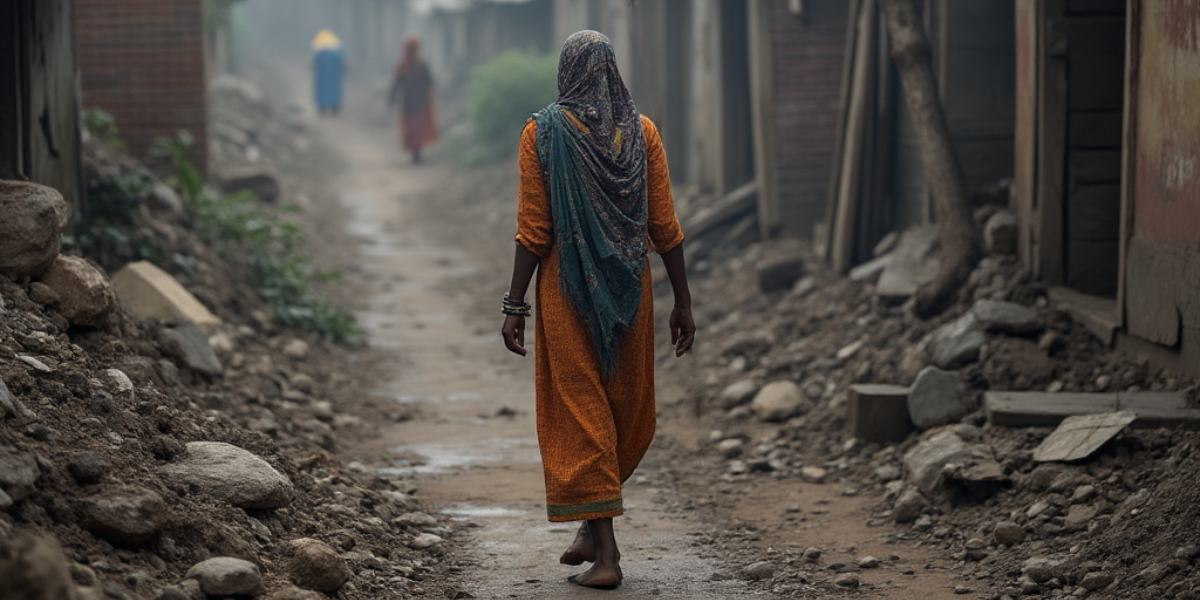The poverty index places India - along with four other countries - as countries with the highest number of poor individuals.
Published Oct 20, 2024 | 10:32 PM ⚊ Updated Oct 20, 2024 | 10:32 PM

India’s poverty rate fell from 57.7 percent in 2011–12 to 23.9 percent in 2022–23.
India has the largest number of people living in poverty globally, with as many as 23.4 crore (234 million) individuals classified as poor, according to the Global Multidimensional Poverty Index (MPI) 2024 by the United Nations Development Programme (UNDP).
This report places India alongside Pakistan, Ethiopia, Nigeria, and the Democratic Republic of the Congo as the top five countries with the highest number of poor individuals, accounting for nearly half of the world’s impoverished population.
The report reveals that India, with its 234 million poor, leads the list, followed by Pakistan with 93 million. The other countries on the list are – Ethiopia with 86 million, Nigeria with 74 million, and the Democratic Republic of the Congo with 66 million respectively.
Altogether, these countries account for 48.1 percent of the 1.1 billion poor people worldwide.
Highlighting the severity of the situation, the report notes, “The five countries with the largest number of people living in poverty are India, Pakistan, Ethiopia, Nigeria, and the Democratic Republic of the Congo, making up nearly half of the world’s poor population.”
The Global Multidimensional Poverty Index (MPI) 2024 is calculated using a robust methodology developed by the Oxford Poverty and Human Development Initiative (OPHI) and the United Nations Development Programme (UNDP). The MPI measures poverty across three dimensions:
Each dimension consists of specific indicators that capture various aspects of deprivation. For example:
In total, there are 12 indicators used to assess multidimensional poverty.
Last year in a report, the NITI Aayog had said that despite these alarming figures, India has made significant strides in reducing multidimensional poverty.
The report from 2023 indicates that multidimensional poverty in India decreased from 29.17 percent in 2013-14 to 11.28 percent in 2022-23, meaning that approximately 24.82 crore (248.2 million) people have escaped poverty in the past nine years.
Based on data from the National Family Health Survey (NFHS-5) conducted between 2019-21, 14.96 percent of India’s population is currently classified as multidimensionally poor, down from 24.85 percent in the NFHS-4 (2015-16). This improvement translates to around 13.5 crore (135 million) individuals moving out of poverty during this five-year span.
A striking finding of the MPI 2024 is the impact of poverty on children. Approximately 584 million children worldwide live in extreme poverty, representing 27.9 percent of all children, which is significantly higher than the poverty rate of 13.5 percent among adults. This disparity underscores the need for urgent interventions to address child poverty, particularly in countries with high poverty rates like India.
India continues to lead in rural poverty globally, with 83.7 percent of the world’s poor in the country residing in rural areas.
The disparity between urban and rural poverty is stark, with 28 percent of the global rural population living in poverty compared to only 6.6 percent of the urban population. Sub-Saharan Africa and South Asia remain the regions with the highest concentrations of poverty, hosting 83.2 percent of the world’s poor population.
In India, the rural-urban gap in poverty rates is also significant. According to NITI Aayog’s report, poverty in rural areas declined from 32.59% to 19.28% between 2015-16 and 2019-21, while in urban areas, it decreased from 8.65% to 5.27%.
The MPI report highlights the severe living conditions faced by the world’s poor:
The MPI report also examines the impact of conflict on poverty, highlighting that nearly 455 million poor people live in countries affected by violent conflict, such as Afghanistan, where poverty rates have surged due to ongoing instability.
According to Achim Steiner, UNDP Administrator in a statement , “Conflicts have intensified and multiplied in recent years, reaching new highs in casualties, displacing millions, and disrupting lives. We must accelerate action to support those living in these conditions.”
Sabina Alkire, Director of OPHI, added, “In conflict-affected countries, multidimensionally poor people face far greater deprivations across all poverty indicators. This study shows that poverty reduction is slower in conflict settings, leaving the poor in these areas even further behind.”
While India has made considerable progress in reducing poverty, the latest MPI report underscores that the challenges remain significant, particularly in rural areas and among children.
The focus now must be on sustained efforts to bridge the gap between urban and rural regions and to ensure that poverty alleviation strategies reach the most vulnerable populations.
The MPI’s comprehensive approach offers a detailed understanding of poverty, guiding policymakers in designing targeted solutions that address the multifaceted nature of deprivation. With ongoing efforts, there is hope that India can continue to make strides in lifting millions out of poverty, ensuring a better quality of life for all its citizens.
(Edited by Neena)
